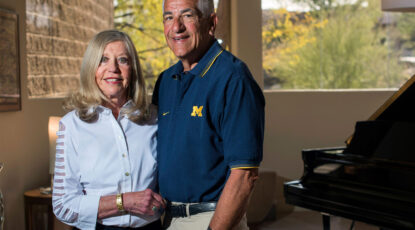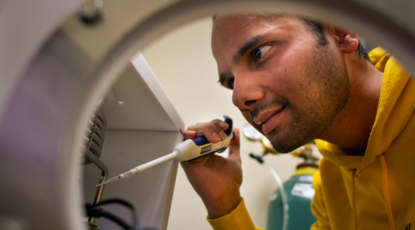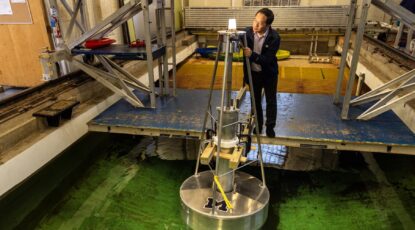Science and Technology
-
U-M receives $50M gift for pancreatic cancer care, research
The gift will create the Rogel and Blondy Center for Pancreatic Cancer. The center will provide support for clinical care and translational research, playing to the strengths of the Rogel Cancer Center’s team of 60 doctors and scientists from 10 departments already working in this area.
-
U-M tops $2B milestone in annual research volume
The University reported a record $2.04 billion in research volume during fiscal year 2024, marking the first time its annual research expenditures have exceeded the $2 billion mark.
-
One mentor’s incredibly fantastic voyage
Nanotechnology pioneer Raoul Kopelman had some very big ideas about some very small things. His legacy permeates modern technology, from precision medicine to artificial intelligence. But his most satisfying role was that of mentor, establishing ties with his students that spanned decades and created immeasurable value in the world.
-
Space Force establishes $35M institute for versatile propulsion and power at U-M
The Space Power and Propulsion for Agility, Responsiveness, and Resilience Institute involves eight universities and 14 industry partners and advisers in one of the nation’s largest efforts to advance space power and propulsion. The institute will be the first to bring fast chemical rockets together with efficient electric propulsion powered by a nuclear microreactor.
-
First data from XRISM space mission provides new perspective on supermassive black holes
Some of the first data from an international space mission is confirming decades worth of speculation about the galactic neighborhoods of supermassive black holes. More exciting than the data, though, is the fact that the long-awaited satellite behind it—the X-Ray Imaging and Spectroscopy Mission or XRISM—is just getting started providing such unparalleled insights.
-
Unlocking ocean power: $3.6M for community-centric wave energy converters
Coastal communities are partnering with a multidisciplinary research team to determine the best way to harvest wave energy at Beaver Island, Michigan, and Nags Head, North Carolina. Wave energy could power millions of homes, but to make a splash in the industry, the tech must balance engineering, socio-economic and environmental trade-offs, researchers say.
-
Watt a journey: Lighting up the Amazon
U-M researchers and engineering students traveled to the far reaches of the Amazon rainforest to help light up rural schools and develop innovative incinerators. Their efforts will support local autonomy, preserve residents’ unique habitats, and generate ecotourism.
-
Auto plants grew their workforces after transitioning to electric vehicle production
Data suggest the switch to electric vehicles may not mean the loss of assembly jobs industry that observers once predicted. Some plants in the ramp-up stages to full-scale EV production saw assembly jobs increase as much as 10 times. The jury is still out in terms of parts manufacturing, though. Those jobs will largely depend on where battery cell manufacturing takes place.
-
Green hydrogen: Powering the future of passenger and freight transportation?
Green hydrogen is emerging as an important potential solution for decarbonizing transportation, but new energy efficiency findings indicate that it should be used strategically in heavy-duty road, rail, aviation, and marine transportation, a U-M study shows.










